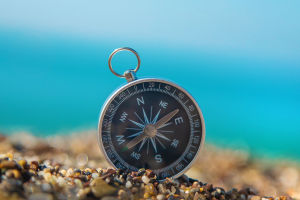Whether hiking, camping, or exploring unfamiliar terrain, a compass guides you safely through the wilderness.
While GPS devices are widely used, they rely on batteries and signals, making the trusty compass a reliable backup.
Here’s a guide to mastering the basics of using an outdoor compass.
1. Understanding Compass Parts
To use a compass effectively, it’s crucial to understand its main components:
Magnetic Needle: This needle points to the magnetic north and typically has a red tip.
Compass Housing: The circular component that surrounds the needle, marked with degrees from 0° to 360°, allowing you to set and read bearings.
Baseplate: A flat, transparent base containing the compass housing, often equipped with a ruler to measure distances on maps.
Direction-of-Travel Arrow: An arrow on the baseplate that indicates your direction of movement.
Orienting Lines and Arrow: These are inside the compass housing, helping align the compass with a map’s grid lines.
2. Taking a Bearing
A bearing is a direction from your current position to a specific destination. To take a bearing:
Hold the compass flat and point the direction-of-travel arrow toward your desired destination.
Rotate the compass housing until the orienting arrow inside aligns with the red end of the magnetic needle.
Read the degree marking where the direction-of-travel arrow crosses the compass housing.
3. Following a Bearing
To navigate along a bearing:
Hold the compass flat with the direction-of-travel arrow facing forward.
Turn your body until the magnetic needle lines up with the orienting arrow.
Walk in the direction the travel arrow points, keeping the needle aligned with the orienting arrow as you go. This ensures you stay on the correct path.
4. Using a Compass with a Map
Lay the map flat on a surface and align the compass baseplate with your route on the map.
Rotate the compass housing until the orienting lines match the map’s north-south grid lines.
Hold both the map and compass together and rotate until the magnetic needle aligns with the orienting arrow. Your compass now shows the direction you should follow according to the map.
5. Adjusting for Declination
Most outdoor compasses allow for declination adjustment. To do this:
Find the declination for your area (often indicated on topographic maps).
Adjust the compass housing by the specified degrees to either east or west to account for the declination.
Mastering the basics of using a compass ensures safer outdoor adventures.
By understanding its components, learning how to take and follow bearings, and using it alongside a map, you can confidently navigate any terrain. Practice these skills in familiar areas before venturing into more challenging environments.


